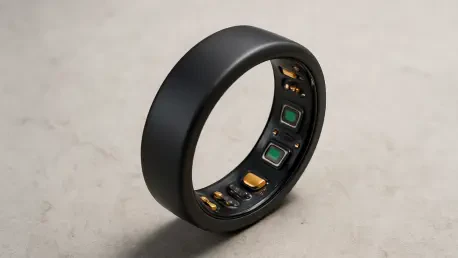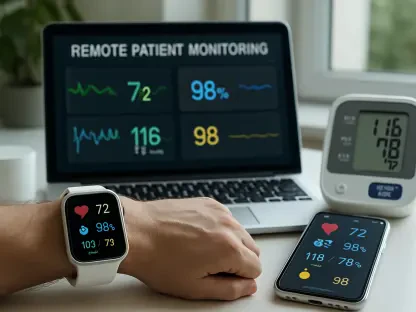In a world where wearable technology is becoming as commonplace as a morning cup of coffee, finding a device that balances style, functionality, and affordability can feel like striking gold. Enter the Omni Health Ring, a sleek contender in the smart ring market that promises to track vital health metrics without the bulk or intrusion of a traditional smartwatch. Priced at an accessible $199 and launched through a successful Kickstarter campaign, this device has garnered attention for its jewelry-like design and comprehensive health tracking features, as highlighted in a detailed review by The Gadgeteer. From sleep monitoring to stress analysis, it aims to cater to those seeking discreet wellness insights.
The appeal of smart rings lies in their ability to blend seamlessly into everyday life, and the Omni Health Ring seems poised to capitalize on this trend with its innovative features. It offers a lightweight build, a robust companion app, and a price point that undercuts many competitors. Yet, with every innovation comes scrutiny—does it deliver on accuracy, especially for activity tracking? Can it truly rival established names in the market? This exploration dives deep into the device’s design, performance, app capabilities, and overall value to uncover whether it matches the needs of health-conscious individuals looking for a minimalist tech solution.
Design and Build Quality
Aesthetics and Comfort
The Omni Health Ring redefines what wearable tech can look like by prioritizing aesthetics that mirror everyday jewelry, making it a standout in the market. Available in three elegant finishes—rose, silver, and black—it resembles a classic wedding band, ensuring it doesn’t scream “gadget” at first glance. This subtle design approach caters to users who value discretion, allowing the ring to blend effortlessly with personal style across various settings, from professional environments to casual outings. The choice of titanium as the primary material not only lends a premium feel but also keeps the weight down to a mere 2.0 to 3.0 grams depending on size, making it significantly lighter than several competing smart rings. At 6.5 mm wide and 2.4 mm thick, its dimensions are akin to a standard ring, ensuring it doesn’t feel cumbersome on the finger even during extended wear.
Beyond its visual appeal, comfort emerges as a cornerstone of the Omni Health Ring’s design philosophy, setting a new standard for wearable technology. The smooth interior surface sets it apart from other smart rings that often feature protruding sensors, which can cause skin irritation over time. This thoughtful engineering means users can wear the device around the clock—whether typing at a desk or sleeping through the night—without noticing its presence. Such attention to comfort addresses a critical pain point in wearable tech, where prolonged use often leads to frustration or abandonment. For anyone hesitant about adopting a health tracker due to concerns about fit or feel, this ring offers a compelling case for reconsideration with its near-invisible wearability.
Durability and Practicality
Durability is a key factor in any wearable device, and the Omni Health Ring rises to the occasion with its robust titanium construction, ensuring it can withstand the rigors of daily life. This material choice guarantees the ring can endure accidental knocks and regular handling without showing signs of wear and tear. Additionally, its waterproof design adds a layer of practicality, allowing users to keep it on during activities like swimming, showering, or even mundane tasks such as handwashing. This resilience eliminates the need to constantly remove and rewear the device, a common annoyance with less hardy wearables, and supports consistent health tracking without interruption.
Practicality extends beyond material strength to how the ring integrates into varied lifestyles, ensuring it fits effortlessly into everyday routines without causing disruption. Its lightweight build and unobtrusive profile mean it rarely interferes with daily activities, whether typing, exercising, or sleeping. Unlike bulkier fitness trackers that can snag on clothing or feel awkward during certain movements, this smart ring maintains a low profile that users often forget they’re wearing. Such seamless integration is vital for devices meant for continuous use, as it encourages adherence to health monitoring routines. For those leading active or busy lives, the Omni Health Ring’s ability to stay out of the way while remaining functional offers a distinct advantage over more intrusive alternatives.
Health Tracking Capabilities
Strengths in Sleep and Stress Monitoring
When it comes to sleep tracking, the Omni Health Ring stands out as a particularly strong performer, catering to a growing interest in optimizing rest for better overall health. The device meticulously records sleep stages—deep, REM, and awake time—along with sleep efficiency, providing users with a detailed picture of their nightly rest patterns. This granular data can be invaluable for identifying issues like frequent waking or insufficient deep sleep, which often impact energy levels and mood. For individuals who struggle with rest or simply want to fine-tune their bedtime routines, the insights offered by this smart ring serve as a powerful tool to foster healthier sleep habits without the discomfort of wearing a bulkier device overnight.
Stress monitoring is another area where the Omni Health Ring excels, offering a nuanced perspective on mental well-being that goes beyond basic metrics. By categorizing stress levels into states such as “deeply at peace” or “stressed,” the device helps users pinpoint moments of tension throughout the day. This feature is particularly useful in today’s fast-paced world, where unrecognized stress can accumulate and affect both physical and emotional health. The ability to visualize stress trends through the companion app empowers users to take proactive steps, such as practicing mindfulness or adjusting workloads during peak stress periods. This focus on mental health tracking positions the ring as a holistic wellness device, appealing to those prioritizing balance over purely physical performance metrics.
Limitations in Activity Tracking
Despite its strengths, the Omni Health Ring faces notable challenges in the realm of activity tracking, particularly with step counting accuracy. The device consistently underreports steps by approximately 25% when compared to wrist-based fitness trackers or smartwatches, a discrepancy likely tied to the smaller, less sensitive accelerometers housed within the ring’s compact form. This limitation reflects a broader challenge in the smart ring category, where space constraints hinder the inclusion of advanced sensors found in larger devices. For casual users, this inaccuracy might be a minor inconvenience, but for those who rely on precise step data to meet fitness goals or track daily movement, it could prove to be a significant drawback.
The implications of this activity tracking shortfall extend to how the Omni Health Ring fits into a user’s fitness journey, particularly in terms of its effectiveness for different types of users. While it captures basic metrics like calories burned and general activity levels, it lacks the precision needed for detailed workout analysis or sports performance monitoring. This makes it less ideal for athletes or fitness enthusiasts who require accurate data to measure progress or optimize training regimens. Instead, the ring seems better suited for individuals focused on general wellness, where broad activity trends suffice over exact numbers. Potential buyers should weigh this limitation against their specific needs, as the device’s strengths in other areas might still outweigh this particular weakness for certain lifestyles.
Companion App and Features
Interface and Data Insights
The companion app for the Omni Health Ring is often described as the heart of the user experience, transforming raw health data into actionable insights with remarkable clarity. Featuring a user-friendly interface, the app provides interactive charts that break down sleep patterns, stress levels, and activity metrics in an accessible format. One standout element is the EnerQi score, a readiness indicator that combines multiple data points to suggest optimal times for high-energy tasks or rest. This holistic snapshot enables users to align their daily schedules with natural energy cycles, a concept gaining traction in productivity and wellness circles. Even in its free version, the app delivers substantial value, ensuring that core functionalities are not locked behind a paywall, which is a refreshing approach in a market often reliant on subscriptions.
Beyond basic data visualization, the app’s depth lies in its ability to foster engagement with health metrics over time, allowing users to gain valuable insights into their well-being. Users can track trends across days or weeks, identifying patterns that might otherwise go unnoticed, such as recurring sleep disruptions or stress spikes on specific days. This long-term perspective is crucial for making informed lifestyle adjustments, whether it’s cutting back on late-night screen time or incorporating stress-relief techniques during high-pressure periods. The intuitive design ensures that even those unfamiliar with health tech can navigate the app with ease, making complex data feel approachable. For anyone seeking a clear window into their well-being without overwhelming technical jargon, this app serves as a compelling bridge between device and daily life.
AI Personalization with Mini
Adding a layer of sophistication to the Omni Health Ring’s ecosystem is Mini, the app’s AI coach, which tailors health advice to individual user data rather than relying on generic recommendations. By analyzing specific trends—such as irregular sleep patterns or elevated stress on certain days—Mini offers personalized suggestions, like adjusting bedtime routines or taking short breaks during stressful hours. This customization sets it apart from standard fitness apps, where one-size-fits-all tips often fail to address unique needs. The AI’s ability to adapt to a user’s evolving health profile ensures that guidance remains relevant, fostering a sense of accountability and encouraging consistent engagement with personal wellness goals.
Another innovative feature tied to Mini is the food scan capability, which uses AI to analyze photos of meals and estimate caloric and nutritional content, offering a unique tool for health-conscious users. While the free version limits scans to a small number per day, this functionality hints at the potential for integrating dietary tracking into broader health monitoring. For users mindful of nutrition, this tool can be a game-changer, though the restriction on free scans might nudge some toward a premium subscription for unlimited access. Nevertheless, Mini’s presence reflects a forward-thinking approach to wearable tech, where personalization and practical innovation converge. This AI-driven customization appeals to those who value targeted insights, elevating the overall utility of the ring beyond basic data collection.
Value and Market Positioning
Competitive Pricing
One of the most striking aspects of the Omni Health Ring is its price tag of $199, which positions it as an attractive entry point into the smart ring market. Unlike higher-end competitors that often cost more than double this amount, the Omni delivers core health tracking features—sleep, stress, and basic activity monitoring—without imposing mandatory subscription fees for essential app access. This affordability broadens its appeal to a wider audience, including budget-conscious consumers or those curious about smart rings but hesitant to invest heavily upfront. The balance of cost and functionality makes it a standout option for anyone looking to explore wearable health tech without financial strain.
The value proposition extends to how the pricing aligns with long-term usability, making it a standout option in the wearable tech market for budget-conscious consumers. Many smart rings and fitness trackers require ongoing payments to unlock full app features, which can accumulate over time and deter potential buyers. By contrast, the Omni Health Ring ensures that fundamental tools remain accessible in the free app version, with premium features as an optional upgrade rather than a necessity. This approach respects user choice and caters to diverse financial situations, enhancing its reputation as a cost-effective alternative. For individuals prioritizing essential wellness tracking over advanced metrics, this pricing strategy offers a refreshing departure from the often expensive wearable tech landscape.
Comparison to Rivals
When placed alongside competitors like the Oura Ring, the Omni Health Ring holds its ground in key areas such as sleep and stress monitoring, where it provides comparable depth in data insights. However, it falls short in offering advanced features like GPS or more sophisticated health metrics, a gap largely attributed to the technological constraints of smart rings’ compact size. This positions the Omni as a device tailored for general wellness rather than specialized fitness tracking, appealing to users who don’t need granular performance data but still want a reliable overview of their health. Its focus on core functionalities at a lower cost makes it a viable choice for a distinct segment of the market.
The distinction in target audience becomes clearer when considering the broader wearable tech ecosystem. While fitness watches and higher-end smart rings cater to athletes or tech enthusiasts seeking cutting-edge capabilities, the Omni Health Ring carves a niche for those valuing discretion and simplicity. Its lack of features like blood glucose monitoring or detailed workout analytics isn’t unique to this device but reflects current limitations across the smart ring category. For potential buyers, this comparison underscores the importance of aligning device capabilities with personal priorities—whether that’s aesthetic integration into daily life or comprehensive fitness tracking. The Omni shines for the former, offering a balanced entry into health monitoring without overwhelming complexity.
User Experience and Support
Battery Life and Charging
A practical highlight of the Omni Health Ring is its impressive battery life, which can last up to 7 days on a single charge, with real-world usage often clocking in at around 6 days based on testing feedback. This longevity is a significant advantage over many wearables that require frequent recharging, often disrupting consistent data collection. For users with busy schedules or those who travel frequently, this extended battery performance means less worry about finding a power source and more focus on leveraging the device’s health insights. The ability to wear the ring continuously without constant charging interruptions enhances its role as a seamless part of daily life.
Complementing the strong battery life is the included charging case, which adds further convenience by allowing 2-3 full recharges before needing to be plugged in itself. The charging process, facilitated via USB-C, takes approximately an hour, ensuring quick turnaround times even when on the go. This thoughtful addition addresses a common pain point in wearable tech, where battery anxiety can undermine user experience. Whether packing for a weekend trip or navigating a hectic week, the charging case ensures the ring remains operational without tethering users to a wall outlet. Such practical design elements underscore the Omni Health Ring’s commitment to user-friendly functionality in real-world scenarios.
Software Updates and Support
The Omni Health Ring benefits from a dynamic software ecosystem, with frequent app updates that signal active development and a commitment to enhancing user experience over time. These updates often address minor bugs or introduce new features, ensuring the device evolves alongside user needs and technological advancements. For instance, early testing revealed a data syncing glitch that was promptly resolved through an update, demonstrating responsiveness to feedback. This ongoing refinement is crucial in a competitive market, where software can significantly influence a device’s long-term value and reliability, keeping the ring relevant as user expectations shift.
Equally important is the support team behind the Omni Health Ring, noted for their quick resolution of issues encountered during initial use. This level of attentiveness fosters confidence among users, particularly for those new to smart rings who might face a learning curve with setup or data interpretation. A responsive support system can transform potential frustration into a positive experience, encouraging continued engagement with the device. Combined with regular software improvements, this dedication to customer care suggests a forward-thinking approach, where user satisfaction remains a priority. For anyone considering this smart ring, the assurance of reliable support and updates adds a layer of trust to the overall package.
Closing Thoughts on Wearable Wellness
Reflecting on the detailed evaluation, the Omni Health Ring carved a notable impression with its blend of style and health-focused features at a competitive price of $199. Its lightweight titanium design and exceptional comfort made it a discreet companion for all-day wear, while robust sleep and stress monitoring offered valuable insights into personal well-being. Though it stumbled with activity tracking accuracy, underreporting steps by a significant margin, the device still catered effectively to those prioritizing general wellness over precise fitness data. The companion app, bolstered by personalized AI coaching, emerged as a highlight, transforming raw metrics into actionable advice.
Looking ahead, potential buyers should consider how their health goals align with the ring’s strengths and limitations. If sleep optimization or stress management tops the list, exploring this smart ring could be a worthwhile step, especially given its affordability and free core app features. For those needing precise activity metrics, it might be prudent to await future iterations with enhanced sensors or to explore wrist-based alternatives. Staying informed about app updates could also unlock added value, as the active development hints at promising refinements. Ultimately, the Omni Health Ring stands as a solid starting point for anyone eager to embrace wearable wellness with a minimalist, budget-friendly approach.









